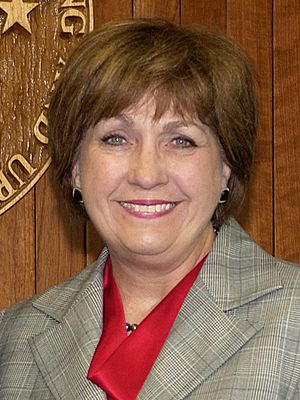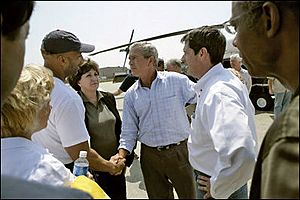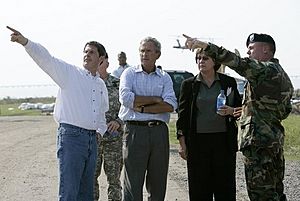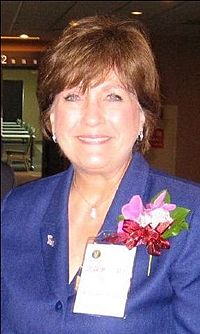Kathleen Blanco facts for kids
Quick facts for kids
Kathleen Blanco
|
|
|---|---|
 |
|
| 54th Governor of Louisiana | |
| In office January 12, 2004 – January 14, 2008 |
|
| Lieutenant | Mitch Landrieu |
| Preceded by | Mike Foster |
| Succeeded by | Bobby Jindal |
| 50th Lieutenant Governor of Louisiana | |
| In office January 8, 1996 – January 12, 2004 |
|
| Governor | Mike Foster |
| Preceded by | Melinda Schwegmann |
| Succeeded by | Mitch Landrieu |
| Member of the Louisiana Public Service Commission from the 2nd district |
|
| In office January 1, 1989 – January 8, 1996 |
|
| Succeeded by | Jimmy Field |
| Member of the Louisiana House of Representatives from the 45th district |
|
| In office March 12, 1984 – January 1, 1989 |
|
| Preceded by | Luke LeBlanc |
| Succeeded by | Jerry LeBlanc |
| Personal details | |
| Born |
Kathleen Marie Babineaux
December 15, 1942 New Iberia, Louisiana, U.S. |
| Died | August 18, 2019 (aged 76) Lafayette, Louisiana, U.S. |
| Political party | Democratic |
| Spouse |
Raymond Blanco
(m. 1964) |
| Children | 6 |
| Education | University of Louisiana, Lafayette (BS) |
Kathleen Marie Blanco (née Babineaux; December 15, 1942 – August 18, 2019) was an American politician who served as the 54th governor of Louisiana from January 2004 to January 2008. A member of the Democratic Party, she was the first and, to date, only woman elected as the state's governor.
When first elected, Blanco outlined her top priorities as providing affordable healthcare, improving the education system in the state, and helping to create a strong and vibrant economy through aggressive economic development initiatives. Her work as governor changed dramatically when, in 2005, coastal Louisiana was severely damaged by two hurricanes that struck less than a month apart. In August, Hurricane Katrina devastated the New Orleans region, an urban area of 1.4 million people. Then, in September, Hurricane Rita struck the southwestern coast, displacing another 300,000 people. More than 200,000 housing units were destroyed, 81,000 businesses closed, entire electrical and telecommunication systems were torn apart, and one million people were made homeless as a result of severe flooding caused by levee failures and storm surges.
Many believed the immediate response from the city, state, and federal governments was inadequate, and Blanco later fully acknowledged there were failures on the part of her administration before and after the storm; however, much criticism, both locally and nationally, was directed at the Federal Emergency Management Agency and at President Bush, for what was seen as a slow initial response to the disaster and an inability to effectively manage, care for and deliver promised resources to those trying to evacuate from New Orleans.
Blanco announced in March 2007 that she would not seek re-election later that year, saying that she would instead "focus [her] time and energy for the [remainder of her term] on the people's work, not on [the] politics" of running for another term. In June 2011 she was diagnosed with cancer, and she died eight years later on August 18, 2019.
Contents
Early life and career
She was born Kathleen Marie Babineaux in New Iberia, Louisiana, the daughter of Louis Babineaux and his wife, the former Lucille Fremin, both of Cajun ancestry. Her Babineaux grandfather was a farmer and grocer with a country store, and her father was a small businessman who moved to the rural hamlet of Coteau, a community near New Iberia with one church and one elementary school. Blanco attended Mount Carmel Academy, an all-girls school run by the Roman Catholic Sisters of Mount Carmel, which was situated on the banks of Bayou Teche. In 1964, Blanco received a Bachelor of Science in business education from the University of Louisiana at Lafayette, then named the University of Southwestern Louisiana. She was also a member of Kappa Delta sorority. On August 8, 1964, she married Raymond Blanco, a football coach and educator; the couple had six children.
Following college, Blanco taught business at Breaux Bridge High School. She then worked for roughly fifteen years as a stay-at-home mom for her six children. She later worked as a District Manager for the U.S. Department of Commerce during the 1980 Census initiative and with her husband, owned Coteau Consultants, a political and marketing research firm.
Prior to her election as governor, Blanco served twenty years in public office. In 1983, elected as the first woman legislator from the city of Lafayette, she served five years in the Louisiana House of Representatives. In her first term, she and her friend Evelyn Blackmon of West Monroe were two of only five women in both houses of the legislature. Blanco in 1988 defeated the Republican Kernan "Skip" Hand to become the first woman in Louisiana elected to the Louisiana Public Service Commission, a post that she held for seven years, She was also the first woman chairman of the PSC. She was then elected Lieutenant Governor, a post that she held for eight years.
Governor of Louisiana
Blanco was elected on November 15, 2003, defeating her Republican opponent Bobby Jindal in the general election, by a margin of 52 to 48 percent. On January 12, 2004, she took the oath of office in both English and French languages, succeeding Murphy J. Foster Jr. She retained Foster's chief of staff Andy Kopplin. She named as the new state commissioner of administration Jerry Luke LeBlanc, who had succeeded her in the state House in 1989 when she became a public service commissioner. Blanco traveled more than her predecessor, seeking new sources of economic development for the state. She visited Nova Scotia and in December 2004 visited Cuba to boost its trade with the state. During this controversial visit, she met with President Fidel Castro, with whom the United States government had no formal diplomatic relations. In 2005, Blanco also visited the Asian countries of Japan, China, and Taiwan.
Despite the upheaval of Hurricanes Katrina and Rita, she met all of her initial goals by the end of her term, most notably prioritizing education investment from pre-kindergarten to the university level. She recruited a number of businesses to Louisiana and established policies to lay a foundation for the recovery of coastal Louisiana.
As governor, she was a member of the National Governors Association, and the Democratic Governors Association, and served as president of the Southern Governors' Association.
Blanco tapped Donald E. Hines, a family physician from Bunkie in Avoyelles Parish, as the president of the state Senate. He held the position during her entire administration.
Hurricane Katrina
On August 27, 2005, Blanco, speaking about Hurricane Katrina, told the media in Jefferson Parish, "I believe we are prepared. That's the one thing that I've always been able to brag about." Later that day, she issued a request for federal assistance and US$9 million in aid to U.S. President George W. Bush, which stated,
... I have determined that this incident is of such severity and magnitude that effective response is beyond the capabilities of the State and affected local governments, and that supplementary Federal assistance is necessary to save lives, protect property, public health, and safety, or to lessen or avert the threat of a disaster. I am specifically requesting emergency protective measures, direct Federal Assistance, Individual and Household Program (IHP) assistance, Special Needs Program assistance, and debris removal.
Also in the request letter, the governor stated: "In response to the situation, I have taken appropriate action under State law and directed the execution of the State Emergency Plan on August 26, 2005, in accordance with Section 501 (a) of the Stafford Act. A State of Emergency has been issued for the State in order to support the evacuations of the coastal areas in accordance with our State Evacuation Plan."
FEMA issued a statement dated August 27, that President Bush authorized the allocation of federal resources, following a review of FEMA's analysis of the state's request for federal assistance. A White House statement of the same date also acknowledges this authorization of aid by President Bush. On August 28, Blanco sent a letter to President Bush, which increased the amount of aid requested to US$130 million. Mayor Ray Nagin, in response to the offer of an Amtrak train to evacuate New Orleans residents, rejected the offer, declared an emergency, and then canceled it. He then flew to Dallas with his family. President George Bush now declared a State of Emergency and brought in U.S. Army Lieutenant General Russel Honoré to be in charge of all forces. The President sent members of the National Guard, the U.S. Coast Guard, the carrier USS Bataan and the U.S. Air Force. It was the largest deployment of military forces within domestic territory since the United States Civil War.
Blanco oversaw the massive evacuation of 93% of the New Orleans area and the subsequent rescue effort utilizing state employees, law enforcement agencies from across the state and nation, citizen volunteers, and federal emergency services such as the U.S. Coast Guard and other U.S. military forces. More than 60,000 people were rescued and removed from the affected region after the storm. As Commander-in-Chief of the Louisiana National Guard, Blanco called on her fellow governors for troop reinforcement as more than a third of her own soldiers and airmen were serving in Iraq and Afghanistan. The response from states delivered nearly 40,000 troops to her command, one of the largest domestic activation of troops in the nation's history.
On September 1, 2005, with reports of looting and lawlessness escalating, Blanco announced she was sending 300 Louisiana National Guardsmen to supplement the New Orleans Police Department.
This followed President Bush's statement that looters in New Orleans and elsewhere in the chaotic aftermath of Hurricane Katrina should be treated with "zero tolerance."
President Bush, during a visit to Louisiana on September 2, 2005, five days after the storm, offered to federalize the Louisiana National Guard to simplify the command structure. The Governor declined, because the Guard would then become part of the federal military forces and therefore lose much-needed policing powers. The President subsequently continued to press the offer, so Blanco rejected it in writing, citing the need for flexibility in National Guard operations, particularly the need for the Guard in areas other than New Orleans where the military was not currently operating. Governor Haley Barbour of Mississippi reportedly declined a similar offer from the President. Had either state's National Guard been federalized, they would not have been able to directly enforce state law (i.e. control looting) under the provisions of the 1878 Posse Comitatus Act. It had not previously been a policy during natural disasters to combine the command of National Guard and military operations under the authority of the President. President Bush had the power to take command of a state's National Guard units under the Insurrection Act of 1807 without the agreement of a state Governor, but no President had done this since Lyndon Johnson in the 1960s and President Bush had so far also declined to do so. However, Blanco and Major General Bennett Landreneau, Louisiana Adjutant General and senior Louisiana National Guard officer, co-operated closely with U.S. Army Lieutenant General Honoré, who was then commanding Federal military operations under Joint Task Force Katrina.
CNN and Fox News reported the Louisiana Homeland Security Department (which operated under Blanco's authority) refused to allow the American Red Cross to enter the city of New Orleans. The American Red Cross confirmed that the organization had not entered the city to provide aid, but also stated that it was providing relief at the evacuation centers: "As the remaining people are evacuated from New Orleans, the most appropriate role for the Red Cross is to provide a safe place for people to stay and to see that their emergency needs are met. We are fully staffed and equipped to handle these individuals once they are evacuated." The deputy director of Louisiana's Homeland Security Department, Colonel Jay Mayeaux, stated that he asked the Red Cross to delay relief operations for 24 hours for logistical reasons, and by the time that was up the evacuations had already begun.
On September 14, after President Bush had accepted responsibility for all problems that occurred at the federal level, Blanco accepted responsibility for all problems that occurred at the state level. Blanco stated, "At the state level, we must take a careful look at what went wrong and make sure it never happens again. The buck stops here, and as your governor, I take full responsibility." In 2006, a Congressional report stated that the "National Response Plan did not adequately provide a way for federal assets to quickly supplement or, if necessary, supplant first responders."
Aftermath and recovery
Blanco continued to press President Bush and Congress for additional recovery funds for Louisiana, pointing out the disparity in assistance received by Louisiana compared to neighboring Mississippi.
Early in 2006, Blanco was inducted into the Louisiana Political Museum and Hall of Fame in Winnfield.
Blanco announced on March 20, 2007, that she would not seek re-election. On January 14, 2008, Bobby Jindal succeeded her as governor.
Health and death
Initially diagnosed with cancer in 2011, Blanco was treated and entered remission. In December 2017, Blanco experienced a recurrence with ocular melanoma metastatic to her liver. A year later at a meeting of the civic association, the Council for a Better Louisiana, Blanco said there is "no escape" from the disease as it had metastasized throughout her body and she has "made peace" with her future. On April 19, 2019, it was announced that she was in hospice care.
Blanco died on August 18, 2019, at the St. Joseph Hospice Carpenter House in Lafayette, Louisiana.
Governor John Bel Edwards later ordered flags across Louisiana to remain at half staff until August 24, 2019, in her honor.
See also
 In Spanish: Kathleen Blanco para niños
In Spanish: Kathleen Blanco para niños
- List of female governors in the United States
- List of female lieutenant governors in the United States




